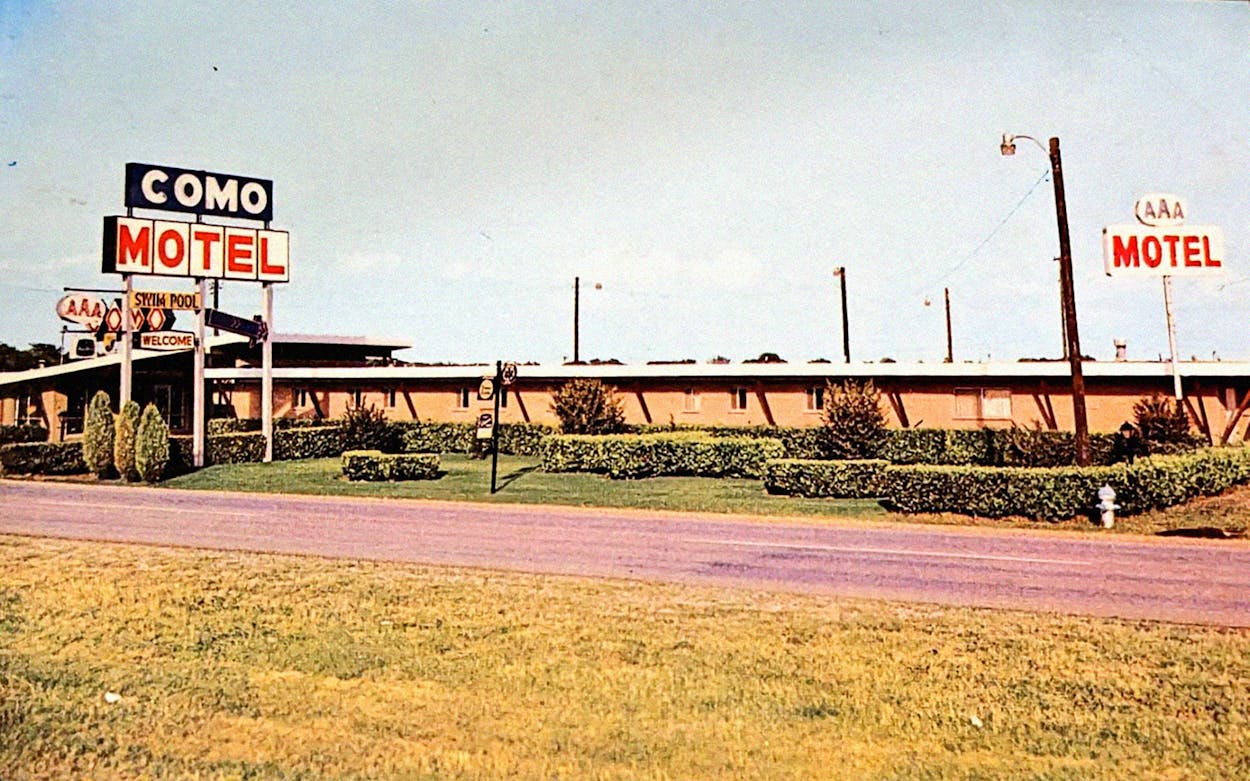When Lindsey Sherritt moved to North Texas fourteen years ago, she lived on Belt Line Road, the looped thoroughfare that encircles Dallas. Each time she exited on the way to her rented home, she’d pass by an eye-catching, retro geometric sign indicating the entrance to the Como Motel.
“Over the years I would pass it and think, ‘One day that’s going to be gone.’ And it just kept standing and standing and standing.”
The longest continually operating motel in Richardson until it stopped taking reservations this month, the Como remains upright, but Sherritt worries that that won’t be the case much longer. She and local business owner Reid Robinson, alongside other activists, are working to save the 67-year-old motel—Richardson’s first, and formerly only—from demolition. This summer, the pair launched a petition to save the Como from a previously unidentified buyer. The petition has since garnered more than 4,800 signatures.
Locals say the destruction of the historic structure would be a tragedy, both because of the building’s mid-century modern architecture and because of its storied history. Famously, the Como was the site of the affair, conducted by Candy Montgomery and Allan Gore, that resulted in the axe killing of Gore’s wife, Betty. The story was retold in the HBO Max series Love & Death, based on Texas Monthly‘s reporting on the crime, as well as Hulu’s Candy. (Texas Monthly was an executive producer on the HBO Max series.) The structure has hosted numerous celebrity guests over the years, including pilot Chesley “Sully” Sullenberger, and is deeply entwined with the advent of the town itself.
In 1955, Dallas-based tech company Texas Instruments purchased lands bordering Richardson and Dallas. One year later, the Como Motel opened, followed shortly by the invention, by a TI employee, of the integrated circuit—and the fomenting of a mini tech boom in Texas’s newly born Silicon Prairie. As engineers moved to the suburb of Richardson, many would have stopped over at the Como Motel as they settled in and toured their families’ future homes.
Situated on the South Central Expressway northeast of Dallas, the motel would have been one of the first structures many tech workers saw as they made their way into the suburb.
“There were people who were building their houses in Richardson Heights and people who were starting their families here that moved to North Texas to be a part of Texas Instruments,” says Robinson, one of the petition organizers. “Googie architecture kind of played to that future rhythm.”
Because of that 1950s economic surge, the town today features several examples of the era’s architecture, including the Googie style, which embodies a sort of space-age, retro idea of the future. Robinson lives in a home built in 1956, the same year as the Como, and operates his business, a nonalcoholic bottle shop, out of a 1958 brise-soleil building.
If the Como’s new owners succeed, Richardson will have one less historic building. Last week, Pappas Restaurants, the Houston-based, family-run group that owns the adjacent Pappasito’s Cantina and Pappadeaux Seafood Kitchen restaurants, closed on the Richardson property for an undisclosed sum. A separate offer from Durkin Properties, which intended to redevelop the motel, was declined. (Former owner Judith Cash declined to comment on the sale.)
Locals suspect that the property will be bulldozed to accommodate a parking lot for the dining establishments next door or another restaurant, though Pappas has not given any indication of its intentions for the one-acre space. Reached by email over the weekend, a representative for the company said:
“Our primary goal in purchasing the property is to make the area more secure for the safety of our guests, team members, and neighbors. We have yet to formalize any plans for development or demolition and are interested in hearing proposals for developing the property.”
The Save the Como cohort met with Pappas in the lead-up to the property’s final sale to propose an adaptive reuse plan that celebrates the motel’s midcentury look. Sherritt envisions a multiuse structure in which the renovated property operates as a motel, a diner, and a day-use pool with cabanas for rent. The group believes that a revitalization could draw visitors and economic benefit to the region. It did not hear from Pappas again before the sale was finalized.
Such development has precedent in Richardson. The town is currently experiencing a downtown revival, spurred by the arrival of an Alamo Drafthouse location—the first in North Texas—in 2013. The theater sits in the Richardson Heights neighborhood, across the expressway from Robinson’s shop and less than one mile from the Como Motel. In the same area, businesses like Staycation Coffee and Lone Chimney Mercantile also inhabit older, midcentury buildings.
Whether the Como Motel will join those structures in entering the next era of Richardson’s history remains to be seen. But for the residents fighting for its survival, it remains a symbol of their town’s past and future.
“This structure is such a touchstone of what this town was turning into [in the 1950s] and what it can be,” says Robinson. “It just seems like a real tragedy to tear it down.”
- More About:
- Texas History
- Style & Design
- Business
- Hotels
- Architecture
- Richardson








